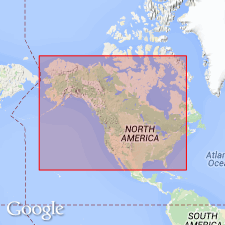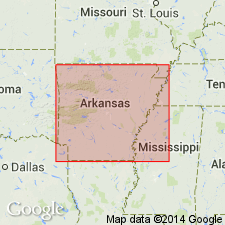
- Usage in publication:
-
- White Bluff marl
- Modifications:
-
- Original reference
- AAPG geologic province:
-
- Desha basin
Summary:
Pg. 343 and table opp. p. 334. White Bluff marl. White Bluff, Jefferson County, southeastern Arkansas. See Harris, Ann. Rpt. Geol. Survey Arkansas for 1892, v. 2, 1894, p. 87. [In chart opp. p. 334 Dall placed "White Bluff marl" at top of Claibornian and above "Claiborne sand." In Harris' report cited in above quotation Harris gave following section of rocks present at White Bluff, but did not use White Bluff marl.]
Soil, Sand and clay, Gravel, 10 ft
Thin-banded light-gray clay, alternating with sand, 10 ft
Green marly clay, with fossils, underlain by light- and dark-colored marls, highly fossiliferous, 60 ft
[The fossils found in above section (some of which are figured on pl. 9, accompanying this report) belong to Eocene Tertiary.]
[GNC remark (ca. 1936, US geologic names lexicon, USGS Bull. 896, p. 2319): The beds referred to belong to Jackson formation, to which they were assigned by Harris.]
Source: US geologic names lexicon (USGS Bull. 896, p. 2318-2319)
- Usage in publication:
-
- White Bluff formation
- Modifications:
-
- Principal reference
- Revised
- Dominant lithology:
-
- Sand
- Marl
- Clay
- AAPG geologic province:
-
- Desha basin
Wilbert, L.J., Jr., 1953, The Jacksonian Stage in southeastern Arkansas: Arkansas Division of Geology Bulletin, no. 19, __ p.
Summary:
Pg. 27-80. White Bluff formation. Resurrected and emended; includes all marine Jacksonian deposits exposed in southeastern Arkansas. Includes three facies: Pastoria sand member (new) and Caney Point marl member, which are stratigraphically equivalent, and Rison clay member, which in places overlies the other members. Outcrops in northern Jefferson County lie near northern limit of Jacksonian outcrop area in this part of the embayment; formation thins northward and disappears; to the south, it dips beneath Redfield formation (new). Overlies beds of Claiborne group; where Caney Point marl member is present, contact is sharp and exhibits evidence of unconformity; where Pastoria sand member constitutes basal unit, contact is not so well expressed. Age is late Eocene (Jacksonian). Type locality designated.
Type locality: White Bluff, a prominent bluff on right bank of Arkansas River, 4 mi east of village of Redfield, in northern Jefferson Co., southeastern AR.
Source: US geologic names lexicon (USGS Bull. 1200, p. 4203)

- Usage in publication:
-
- White Bluff Formation
- Modifications:
-
- Overview
- AAPG geologic province:
-
- Desha basin
Summary:
Pg. 34 (Jackson entry). White Bluff Formation, lower marine unit in Jackson Group. Blue gray to off white. Has three dominate facies: an argillaceous sand containing glauconite and rich in molluscan fossils, a calcareous glauconitic clay with common invertebrate fossils, and a blocky clay with some silt and a trace of sand and invertebrate (mostly molluscan) molds. Underlies nonmarine Redfield Formation of Jackson Group. Age is late Eocene.
Source: Publication.
For more information, please contact Nancy Stamm, Geologic Names Committee Secretary.
Asterisk (*) indicates published by U.S. Geological Survey authors.
"No current usage" (†) implies that a name has been abandoned or has fallen into disuse. Former usage and, if known, replacement name given in parentheses ( ).
Slash (/) indicates name conflicts with nomenclatural guidelines (CSN, 1933; ACSN, 1961, 1970; NACSN, 1983, 2005, 2021). May be explained within brackets ([ ]).

